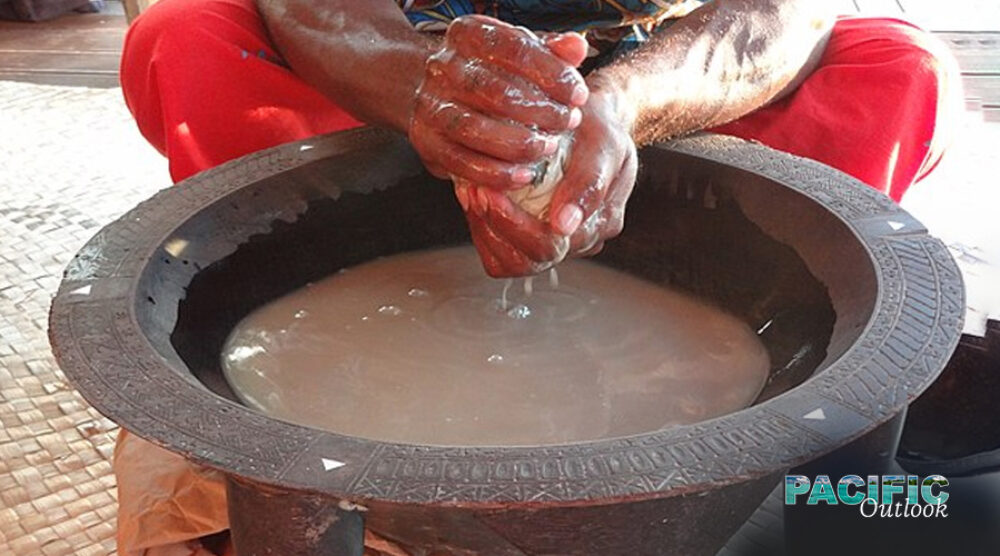In some parts of Vanuatu, women are still forbidden from entering a nakamal, or ‘kava bar’, as it is traditionally a space where men would gather for decision-making and other discussion at the end of each day.
In Tanna, for example, women’s preclusion from kava drinking remains, where it’s looked upon unfavourably for a woman to order their own shells (servings of kava) or enter the nakamal at all once kava drinking has begun.
The commercialisation of the ceremonial drink however, particularly in areas where Western culture has had a greater influence, has seen women’s involvement become more socially, economically, and culturally accepted.
Joseph Brun has been in the industry for 30 years, starting out in nakamals and now working in the export trade. He said the practice of kava drinking has changed in recent years.
“Kava [was] only used by men, or before that was only used by chiefs and his people. That was in the old days until kava became commercialised when we started making kava bars,” Joseph said.
He said women only started drinking kava in nakamals within the last seven or so years.
“I think we evolved from the past traditional cultural way.”
Vanuatu is an island archipelago rich in history and brimming with traditionalstories, such as those detailing the origins of kava throughout the country.
Ni-Vanuatu locals are often happy to share their stories with visitors, although a sense of reluctance often arose when asked about the origin of kava and the restrictions around women drinking it.
“Kava was originated in the traditional kastom stories. Kava was originated from a woman,” Joseph said.
Australian anthropologist Ron Brunton, through his extensive research into kava (see The Abandoned Narcotic: Kava and cultural instability in Melanesia published in 1989), spoke with people on Tanna, and elsewhere in Vanuatu, about the plant extract and its origins:
“When pressed, the kinds of explanations my informants offer for the prohibition of women drinking kava, or watching men consume it, focus on shame: as it originally came from a woman’s vagina, both men and women felt shame in the presence of the other sex, given what is being done to the kava.”
Brunton’s research indicates kava was consumed on a yimwayam, a large clearing of ground shaded by banyan trees, where women were permitted until around the hour before sundown, when preparations for kava drinking would begin.
During such time, women were to use alternative paths that bypass the area, a tradition many villages, such as in Port Resolution on Tanna, still honour today.
But Brunton suggests women still had an important role, despite their immediate presence being prohibited, in preparing the food men consumed during the ritual.
Today, however, women in Vanuatu have greater participation where they now drink, grow, and sell kava, including owning their own nakamals in some urban areas such as Port Vila.
Josh Rasu, originally from Espiritu Santo and now living on Efate, said prayer remains important in kava rituals, despite other cultural shifts surrounding the crop.
He said tipping a bit from your first shell onto the soil is considered a way of giving back to the earth from where the kava came.
“That’s for our ancestors, like giving it back to them, giving it back to nature,” he said.
“You can have good luck, you can have a good life, and if you want something, you can [do it] like a toast.”
Josh said women’s issues have played a role in the evolution of women drinking kava and, over time, kava has become less sacred.
“Now everything’s changing. Women drink kava, we don’t mind anymore,” he said.
“It’s like part of our culture wearing off.”
Charle David Nasu, a farmer from Lamtawekel village, said the arrival of Christianity tried to ban kava on Tanna some decades ago, but as an important part of ni-Vanuatu culture, kava’s revival sees it widely consumed today.
“We created kava bars to bring peace, to unite people, so today you drink kava anywhere,” he said.
With links to death, sorcery, spirit, religion, and other traditional custom, the ceremonial drink is still exchanged at significant occasions such as marriage, a woman’s first period, and male circumcision.
Despite progression in recent years, men appear to remain the prevailing sex in the kava industry.
While restrictions on women and kava are often seen as a misconception of gender bias, locals suggest they’re rather a way of honouring traditional culture, an ever-important factor across the entirety of Vanuatu.
Nikki Richardson is a writer and journalist from Meanjin/Brisbane and Griffith University student with interests in environmental and humanitarian issues.








